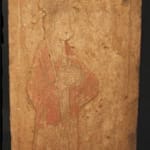Painted Relief Panel Depicting an Attendant, 960 CE - 1279 CE
Stone
20.75
H.660
The Sung (Song) Dynasty partially reunified China after a period of chaotic turmoil following the fall of the T’ang. Historically, the Sung are noted for their revival of the ancient...
The Sung (Song) Dynasty partially reunified China after a period of chaotic turmoil following the fall of the T’ang. Historically, the Sung are noted for their revival of the ancient Confucian beliefs, ushering a period known as Neo-Confusianism that would dominate Chinese (and later on Japanese) thought for the next several centuries. Although best known for their philosophical contributions, this relief panel attests to the rich artistic tradition that flourished under the enlightened rulers of the Sung Dynasty. Discovered buried inside a tomb, this gorgeous rectangular panel, sculpted in low relief, depicts a beautiful female attendant patiently awaiting the command of her master. Her hair is elegantly styled and she wears a tunic, painted red, covering her long flowing robes. She carries a vessel of sorts in her two hands, perhaps a teapot, seemingly offering us a taste. However, this beverage is meant for consumption in the afterlife. Thus, this attendant would have continued to serve her master even after his earthly demise. The tradition of elaborate burial tombs containing treasured relics from life and sculpted replica of courtly entourages dates back to the earliest dynasties of China. By the time of the Han (206 B.C.-220 A.D.), this practice had become entrenched in Chinese culture. These elaborate burials reflect the ancient philosophical and religious belief that the afterlife was an extension of our earthly existence. This work is created out of an age-old tradition assuring that the deceased was welcomed into the next world and well provided for. With gorgeous surroundings such as this panel ushering one into the afterlife, heaven must be even more spectacular than ever imagined.



